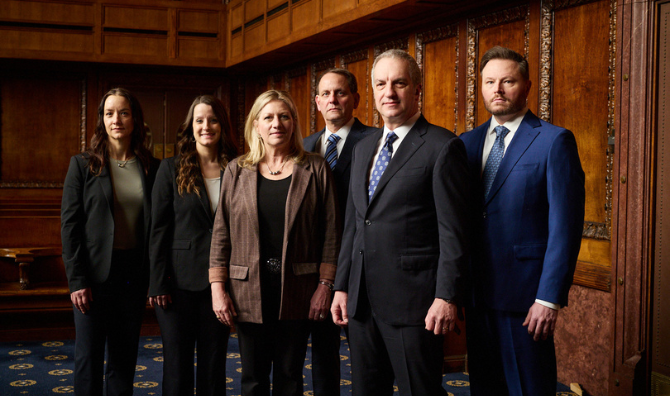Stroke – or cerebrovascular accident (CVA) – is the leading cause of disability among U.S. adults, and though it is common, stroke can be effectively prevented and treated. Unfortunately, it often isn’t.
According to the American Heart Association, doctors overlook or discount early signs of potentially devastating stokes in tens of thousands of Americans each year, delaying critical treatment that can improve outcomes and reduce risks of recurrent strokes, permanent disability, and death.
If you or a loved one were harmed by a health care provider’s failure to properly evaluate, diagnose, or timely treat stroke, you may be entitled to compensation.
The Becker Law Firm has secured millions for medical malpractice victims across Ohio and the U.S., and is available to evaluate your potential case.
Call The Becker Law Firm today at 216-621-3000 to discuss your case in a free consultation with our failure to diagnose stroke lawyers in Cleveland.
Stroke Misdiagnosis Lawsuits
Providers who see stroke patients or serve as their first point of contact know treatment of acute stroke has inherent risks for malpractice litigation. In fact, statistics show failure to diagnose or delayed diagnosis among the leading causes of all malpractice claims.
That being said, anyone with a potential case must understand medical malpractice lawsuits are extraordinarily complex and fact-specific. Determining if there are grounds to pursue legal action requires a thorough evaluation of the circumstances involved; litigating them successfully demands the attention of skilled and proven trial attorneys.
Although the individual facts of a case matter, most malpractice claims raise allegations that a provider was negligent. Per the legal definition of malpractice, this means a deviation from the accepted minimum “standard of care” (or breaching a “duty of care”) when assessing or treating patients.
For stroke malpractice claims, negligence can take many forms, including:
- Inadequate evaluations or neurological exam / failure to obtain medical history
- Failure to timely administer tPA or timely perform thrombectomy
- Missed warning focal findings, signs, and symptoms / failure to distinguish stroke from other conditions
- Failure to diagnose heart disease, high blood pressure, atrial-fibrillation, atherosclerosis, and other risk-factor conditions
- Failures to refer patients to neurologists or consult appropriate specialists
- Failure to transfer patient to another hospital, stroke center, or provider
- Delays or failures to order or follow up on appropriate tests, including CT or MRI scans
- Misreading or misinterpreting test results
- Hospital negligence / emergency room errors
- Surgical errors / postoperative care errors
What Stroke Malpractice Claims Look Like
Every medical malpractice case is unique, and those involving stroke can vary – from the claims alleged by plaintiffs to the type of stroke or medical issues involved, defendants named in the suit, and damages suffered.
Ischemic Stroke
The most common type of stroke, ischemic stroke occurs when blood flow to the brain is obstructed by a clot. These clots may come from the heart (embolic) or blood vessels in the brain (thrombotic), as well as atherosclerosis and plaque in the arteries.
Ischemic strokes can affect different areas of the brain (anterior / posterior, brainstem, cerebrum, cerebellum) and present with different symptoms, but they all deprive the brain of oxygen and result in permanent cell death / brain damage (cerebral infarction).
Deficits caused by ischemic stroke can vary depending on which part of the brain was affected. Early diagnosis, intervention, and treatment is important in minimizing onset-to-treatment gaps, and avoiding or reducing the severity of a stroke’s effects, particularly for posterior circulation and brainstem strokes, and younger patients.
Administration of tissue plasminogen activator (tPA), a clot-busting drug, or a thrombectomy can be effective in treating ischemic stroke, but they must be performed within a short time frame after onset.
Hemorrhagic Stroke
Hemorrhagic stroke occurs when a blood vessel in the brain ruptures and prevents blood flow to brain cells. Hemorrhagic strokes include both intracerebral hemorrhage (bleeding from vessels within the brain) and subarachnoid hemorrhage (bleeding between the brain and its membrane), and are more likely to result in death than ischemic strokes, making timely diagnosis critical.
Transient Ischemic Attack (TIA)
Known as a transient ischemic attack, a TIA is a “mini stroke” caused by a temporary clot. Failures to diagnose a TIA and appropriately treat patients can substantially increase risks of a more severe stroke.
Defendants in Stroke Malpractice Claims
- ER doctors, PA’s, nurses
- Primary care doctors (PCP), family doctor
- Hospitals / emergency departments
- Neurologists, neurosurgeons
- Cardiologists
- Radiologists
- Other negligent providers
Damages Victims & Families May Recover
If a doctor, specialist, hospital, or other provider failed to meet their duty of care when treating a stroke patient – in other words, failed to evaluate or treat patients with the level of skill a reasonably careful medical professional would use in the same or similar circumstances – they may be held liable for damages suffered by victims and their families.
Death & Disability
For stroke survivors and their families, securing a financial recovery of damages can be as important as seeking justice and accountability. That’s due to the devastating repercussions which can result from a missed or delayed stroke diagnosis, including wrongful death and injuries such as:
- Permanent disability or disfigurement
- Impaired muscle coordination (apraxia) of arms, hands, legs, and muscles
- Paralysis / weakness of muscles on one side of the body (hemiparesis)
- Difficulties with speech or language (aphasia) or feeding / swallowing (dysphagia)
- Vision loss (hemianopia, visual field cut, peripheral / hemispatial neglect, etc.)
- Cognitive deficits affecting short-term memory, critical thinking, reasoning, judgment, spatial awareness / depth perception, and mood / behavior
- Loss of independence / need for assistance with daily tasks
Economic & Non-Economic Losses
Stroke survivors and families can incur numerous economic and non-economic losses, including:
- Lost income, reduced earning potential, or inability to work
- Costs for medical treatments, therapy / rehabilitation, assistive care, medications, and medical devices or accommodative products
- Physical and emotional pain and suffering, depression, and anxiety
- Loss of enjoyment or quality of life
- Loss of consortium, companionship, and emotional support
- Grief and emotional suffering of family members
Your ability to file a medical malpractice claim and secure compensation will depend on the facts of your case. Because malpractice cases have a statute of limitations (or time limit) beyond which no claim can be filed, we encourage victims to contact our team as soon as possible.
How often do doctors fail to diagnosis stroke?
Researchers at Johns Hopkins estimate doctors overlook tens of thousands of stokes each year, and one study published by the American Heart Association found more than 20% of strokes were missed by Emergency Departments and neurologists.
While there are different types of stroke, different areas of the brain affected, and different manifestations of warning signs and symptoms, experts still suggest many patients who present to ER departments and neurological practices are inadequately evaluated, not diagnosed, or diagnosed with stroke “chameleons” such as hypertensive emergency, vertigo, or infection.
Missed diagnosis rates increase when certain circumstances are present, including:
- Posterior circulation stroke (3x more likely to be missed than anterior strokes)
- Patients with multiple risk factors;
- Younger patients / women;
- Symptoms of dizziness, vertigo, headaches, nausea / vomiting, seizure, syncope, vision changes and difficulty walking;
- Patients who present to community hospitals.
What tests should a doctor order to diagnose stroke?
Diagnosing any medical condition is dependent on comprehensive evaluations and case-specific circumstances. That being said, there are accepted “guidelines” for diagnosing stroke.
Apart from in-person assessments using the National Institutes of Health Stroke Scale (NIHSS) or other stroke scales / protocol, providers often obtain patients’ medical histories, blood pressure and vital readings, and engage in conversation about the onset, duration, severity, and scope of symptoms. Vision tests, balance tests, blood testing, and EKG / ECG are also commonly used.
For imaging tests, CT scans (usually without contrast) have long been the de facto “standard” for diagnosing acute stroke, despite a lack of formal assessment of its accuracy. Today, new studies and evidence suggest CT scans may not be as effective in diagnosing ischemic strokes (the most common type of stroke) as MRIs. MRIs use magnets and radio waves which show a clearer image of brain tissue, and may better reveal stroke severity and lesions.
Though the American Academy of Neurology published a new guideline for using MRI scans to diagnose stroke rather than CT scans in 2010, providers still rely heavily on CT scans, which are more widely available and more feasible and affordable than MRI, especially in community hospitals and emergency room settings. Doctors may also order CT Angiography (CTA) for comparison with MRI /DWI, MR Angiography (MRA), Transcranial Doppler (TCD), or conventional angiography (DSA), among other imaging tests.
A personal evaluation of your case would be necessary to determine what tests would have been reasonably expected, and whether a standard may have been missed.
Is it malpractice when a doctor misses a stroke diagnosis?
In short, not always. Whether a doctor could and should have diagnosed a stroke depends greatly on the individual facts. As with other medical malpractice cases, the standard can vary depending on the circumstances, and strokes – which can be difficult to diagnose in and of themselves – may present in vastly different and difficult-to-diagnose ways.
Cases of stroke misdiagnosis, delayed diagnosis, or failure to diagnose which have been successful in the Courts typically raise allegations that providers failed to meet the applicable standard – that is, they failed to act in a manner a reasonably skilled medical professional would have acted under the same or similar circumstances.
This could mean failing to perform thorough assessments, consult neurologists or appropriate providers, order necessary tests in a timely fashion, or administer appropriate and timely treatment given the set of facts and patient’s symptoms.
The standard for diagnosing stroke may vary from case to case, but missed stroke malpractice claims are more likely to be filed when doctors are accused of missing standards related to:
- Using a hospital’s stroke activation protocol (for triage / acute care);
- Offering tPA treatment to candidates who present within the time window;
- Consulting neurologists or specialists;
- Adequately documenting timing of symptom onset;
- Ordering appropriate tests (i.e. CT, MRI);
- Transferring patients / referring patients;
- Conflicting examinations / documenting focal findings.
Who is liable for damages caused by a missed or delayed stroke diagnosis?
It depends. If a person had presented to their primary care physician or neurologist with symptoms that should have reasonably identified, it may be possible to pursue claims against those providers. In an emergency room or hospital setting, liability for delayed or missed diagnoses may fall upon ER doctors, radiologists, PA’s, hospitals, or any combination of parties involved in a patient’s coordinated care.
While the facts of your case will determine who may be held liable for damages, a study from Icahn School of Medicine at Mount Sinai published by the journal Stroke shows:
- Half of stroke malpractice cases named both doctors and hospitals as defendants; 30% and 20% named solely a doctor or hospital as defendant.
- ER doctors were most likely to be sued over stroke malpractice (33% of cases reviewed), followed by PCP / family doctors, neurologists, neurosurgeons, and radiologists.



